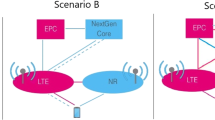Abstract
This article outlines the economic feasibility of mobile operators that combine nationwide mobility with 3G networks and hot spot coverage withWLANS, WLANS are based onHIPERLAN/2 architecture and theUMTS network exploitswCDMA/FDD technology. The evaluated business scenarios are focused on two different deployment areas, in terms of demographic characteristics and mobile penetration: a large and a small European country. The business case spans 2002 to 2011 withUMTS’ roll-out year in 2002 andWLAN’s in 2004, covering indoor hot-spot areas (stations, airports, stadiums, etc.) where demand is high. The demand for thisUMTS-WLAN roaming case is evaluated based on observations from Europe’s current mobile market and its evolution. Usage scenarios of different service packages corresponding to both residential and business markets have been taken into account. Direct investments and operational costs as well as revenue streams from traffic have been calculated. The methodology and the tool developed inACTS-TERA [1] andIST-TONIC [2] projects have been utilized for this case study. Economic conclusions have been derived, presented and discussed using key profitability factors. Profitability for all scenarios and business profiles has been calculated, presented and discussed. It includes a sensitivity analysis in order to identify the major opportunities and threats, for specific service sets as well as critical parameters and uncertainties. A wide audience from mobile operators and service providers to retail companies interested in entering the 3G market, can exploit this information.
Résumé
Cet article souligne l’attrait pour les opérateurs mobiles que constitue la couverture des lieux publics à forte fréquentation par les réseauxRLAN en combinaison avec les réseaux 3G. les réseauxRLAN sont basés sur l’architectureHIPERLAN/2 et les réseauxUMTS sur la technologiewCDMA/FDD. Les scénarios économiques étudiés ont ciblé deux différents types de pays en terme de caractéristiques démographiques et de pénétration de la téléphonie mobile: un grand pays européen et un petit. Le plan d’affaire court sur 2002–2011 avec déploiementUMTS en 2002 et déploiementRLAN en 2004 pour la couverture des lieux publics à forte fréquentation tels que les gares, aéroports, stades, etc. où la demande est élevée. La demande dans ce modèle économique est estimée à partir de l’analyse du marché actuel de la téléphonie mobile en Europe et de son évolution. Les scénarios d’usage des différent services correspondant aux segments de marché entreprises et particuliers ont été pris en compte. Les investissements, le coût opérationnel ainsi que les revenus générés par le trafic ont été calculés. La méthodologie et l’outil développés dans les projets européensACTS-TERA etIST-TONIC ont été utilisés pour cette étude de cas. Les conclusions sont présentées avec une analyse de facteurs clés ainsi qu’une analyse de sensibilité incluant permettant d’identifier les principaux risques et opportunités.
Similar content being viewed by others
References
http://www.telenor.no/fou/prosjekter/tera
http://www-nrc.nokia.com/tonic/
Sonera press release June 4, 2001: “Sonera’s wireless broadband Internet service expands to all airports ofCAA Finland” http://www.sonera.fi/english/pressinfo/releases/EngSonera2001/2001/43.html
ETSI http://webapp.etsi.org/workprogram/Report_WorkItem.asp?wki_id=7079.
TR 101 031 v2.2.1 (1999–01), Broadband Radio Access Networks (BRAN);HighPerformanceRadio Local Area Network (HIPERLAN) Type 2; Requirements and architectures for wireless broadband access.
TR 101 957 v1.1.1 (2001–08), Broadband Radio Access Networks (BRAN);HIPERLAN Type 2; Requirements and Architectures for Interworking betweenHIPERLAN/2 and 3rd Generation Cellular systems
http://www.ist-brain.org/
http://www.ist-mind.org/
Hancock (R.),Aghvami (H.),Kojo (M.),Liljeberg (M.) “The Architecture of theBrain Network Layer” Proc. IST Mobile Communications Summit 2000, Galway, Ireland, 1–4 October 2000, pp 581–586
Young (A.) “Hong Kong, U.K. mull licensingWLAN spectrum” at the address http://www.totaltele.com/.
Katsianis (D.) et al., “The financial perspective of the mobile networks in Europe”,IEEE Personal Commun. Mag., Dec. 2001,8, No 6, pp 58–64.
Ims (L. A.), “ConsideringVDSL as a multiservice technology and a key weapon for telecom operators in the TV and video on demand market”, Broadband Access Networks, 22–25 Oct., 2001, Amsterdam.
“Broadband Access Networks Introduction strategies and techno-economic evaluation”, Telecommunications Technology And Applications Series, Chapman & Hall 1998,ISBN 0 412 828200.
Cerboni (A.)et al., “Evaluation of demand for next generation mobile services in Europe”, Third European Workshop On Techno-Economics For Multimedia Networks And Services, Aveiro 14–16 December 1999.
Stordahl (K.),Ims (L. A.),Moe (M.), “Broadband market — the driver for network evolution”, Proc. Networks 2000, Toronto, Canada, September 10–16, 2000.
Velez (F. J.), Correia (L. M.), “Mobile broadband services: Classification, characterization, and deployment scenarios”,IEEE Communications Magazine,40, no 4, Apr 2002 pp. 142–150.
Stordahl (K.),Kalhagen (K O),Olsen (B. T.), “Broadband technology demand in Europe”, Proc.ICFC 2002, San Francisco,USA, June 25–28, 2002.
Stordahl (K.)et al., “Traffic forecast models for the transport network”, Proc Networks 2002, Munchen, Germany, 23–27 June, 2002.
Strategy Analytics Insight, “You want how much per Megabyte?”, 8/12/2000.
Strategy Analytics Industry Report, “Global Cellular Data Applications, Revenue, & 3G Migration”, December 2000.
Analysis, “Public wirelessLAN access: Market forecasts”, 2001.
OVUM, “Global wireless market forecasts 2002–2006”, 2002.
IDATE, Mobile Data Services (Europe only, October 2002).
Forrester, “Europe’sUMTS Meltdown”, December 2000.
Lehman Brothers, Report on Vodafone, December 5, 2000.
Jupiter Vision Report — “Broadband and Wireless — Mobile Milestones: Tune services for islands of innovation”, December 2000.
BDRC, The Development of Broadband Access Platforms in Europe, Technologies, Services, Markets August 2001.
OECD, Development of Broadband Access 2001.
Strategy Analytics, “Residential Broadband”, 2001.
Strategy Analytics, “Western European Cellular Market forecasts 2001–2006”, 2001.
Broadband penetration across Western Europe is still less than half that in theUS”, Analysis, March 2002.
Author information
Authors and Affiliations
Rights and permissions
About this article
Cite this article
Varoutas, D., Katsianis, D., Sphicopoulos, T. et al. Business opportunities throughUMTS-WLAN networks. Ann. Télécommun. 58, 553–575 (2003). https://doi.org/10.1007/BF03001028
Received:
Accepted:
Issue Date:
DOI: https://doi.org/10.1007/BF03001028
Key words
- WirelessLAN
- Mobile radiocommunication
- UMTS
- Network interworking
- Economic aspect
- Telecommunication operator
- Telecommunication regulation
- Demand forecasting
- Economic forecasting




